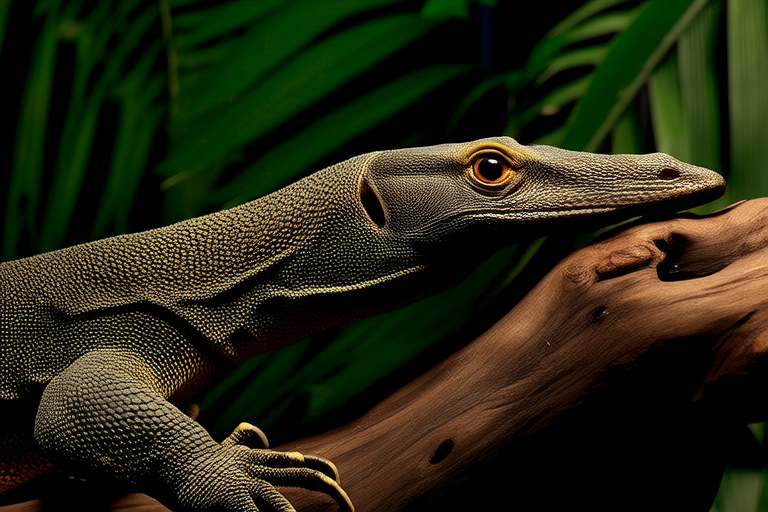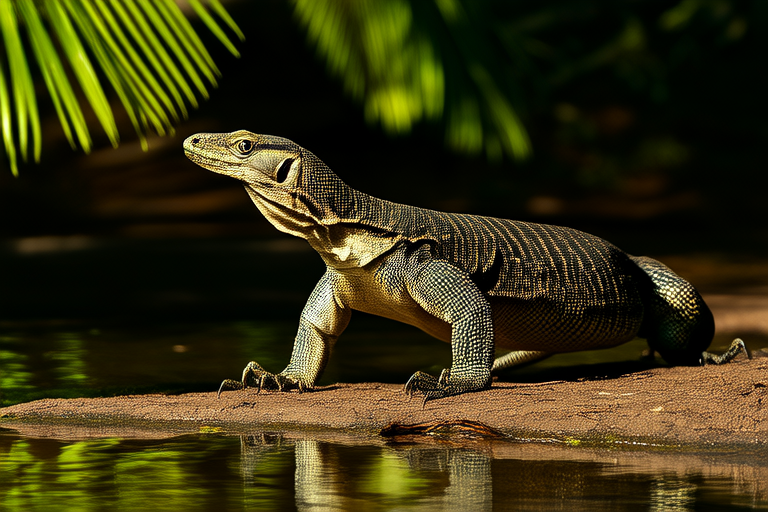
From Jungle to Home: How to Care for Your Exotic Water Monitor
Welcome to the fascinating world of water monitors, one of the most impressive reptiles you can bring into your home. These creatures, native to Southeast Asia, are known for their striking appearance, intelligence, and unique behaviors. Caring for a water monitor requires dedication, knowledge, and a deep understanding of their specific needs. This guide will walk you through the essentials of providing a suitable environment, proper diet, and care for your exotic pet.
The Unique Characteristics of Water Monitors
Water monitors (Varanus salvator) are among the largest lizards in the world, capable of growing up to seven feet long. Their sleek bodies are designed for swimming, with powerful tails that help them navigate both land and water. Their coloration varies from dark green to brown, often with yellow or cream-colored markings. They possess keen eyesight and an acute sense of smell, which they use to locate prey. Water monitors are intelligent and curious animals, making them engaging companions if properly cared for.
Natural Habitat and Adaptations
In their natural habitat, water monitors thrive in tropical forests, mangroves, and riverbanks. They are semi-aquatic, spending time both in water and on land. These environments provide ample opportunities for hunting, basking, and hiding. The high humidity and warm temperatures typical of these regions are crucial for their well-being. Understanding these conditions is key to replicating a suitable living space for your pet at home.
Setting Up a Suitable Living Environment
Enclosure Size
One of the first considerations when preparing a home for your water monitor is the size of its enclosure. A young monitor can be housed in a smaller tank, but as they grow, they require significantly more space. Adult water monitors need enclosures that are at least 8 feet long, 4 feet wide, and 6 feet tall. This allows them plenty of room to move around, swim, and explore. It’s important to ensure that the enclosure is escape-proof, with secure lids or tops.
Temperature Regulation
Water monitors are ectothermic, meaning they rely on external sources to regulate their body temperature. Providing a temperature gradient within the enclosure is vital. One end should be warmer, around 90-95°F (32-35°C), while the cooler end should be about 75-80°F (24-27°C). Use heat lamps, ceramic heat emitters, or under-tank heaters to achieve this gradient. Nighttime temperatures can drop slightly, but never below 70°F (21°C).
Humidity Levels
Maintaining proper humidity levels is essential for your water monitor’s health. Aim for a humidity range of 60-80%. This can be achieved through misting systems, water dishes, and humidifiers. Ensure there is always fresh water available for drinking and soaking, as water monitors spend a significant amount of time in the water.
Appropriate Substrate
Selecting the right substrate is important for your monitor’s comfort and hygiene. Avoid substrates that can cause impaction, such as sand or gravel. Instead, opt for a safe alternative like reptile carpet, paper towels, or a mixture of coconut fiber and sphagnum moss. Regular cleaning and changing of the substrate are necessary to maintain a healthy environment.
Dietary Needs and Feeding Habits
Water monitors are carnivorous and have a diverse diet in the wild, consisting of fish, insects, small mammals, and birds. In captivity, their diet should mimic this variety. Younger monitors can be fed daily, while adults may require food every other day. A balanced diet includes:
- Prey items like mice, rats, chicks, and feeder fish.
- Variety of insects such as crickets, mealworms, and dubia roaches.
- Fresh vegetables and fruits, although these should be minimal compared to animal protein.
Feeding should be done in a separate container to prevent substrate ingestion. Always ensure that prey items are appropriately sized; too large can lead to choking, and too small may result in overfeeding.
Nutritional Supplements
To maintain optimal health, it’s recommended to supplement your monitor’s diet with calcium and vitamin D3. Dust feeder insects with a high-quality calcium powder and offer a multivitamin supplement once a week. Over-supplementation can be harmful, so follow the manufacturer’s guidelines carefully.
Social Interaction and Handling Techniques
Water monitors are generally solitary animals in the wild, but they can form bonds with their human caregivers. However, they are not typically affectionate pets and may exhibit defensive behavior if mishandled. When interacting with your monitor, approach slowly and calmly. Always support their body, especially their belly, to avoid causing stress or injury. Regular, gentle handling can help your monitor become accustomed to being touched, but never force interactions.
Mental Stimulation Activities
Providing mental stimulation is crucial for keeping your water monitor engaged and happy. Offer enrichment activities such as puzzle feeders, climbing structures, and water features. Rotate toys and accessories periodically to keep the environment interesting and challenging.
Routine Veterinary Care
Regular check-ups with a veterinarian experienced in reptile care are essential. Schedule annual visits to monitor your monitor’s overall health and address any concerns early. Keep track of weight changes, skin condition, and general behavior. Vaccinations are not typically required, but vaccinations against certain diseases may be recommended based on local regulations or your vet’s advice.
Common Health Issues
Like all pets, water monitors are susceptible to various health problems. Some common issues include respiratory infections, parasites, metabolic bone disease, and mouth rot. Early detection and treatment are critical for recovery. Watch for signs such as lethargy, loss of appetite, difficulty breathing, swollen eyes, or unusual discharge from the mouth or nose.
Signs of Distress
It’s important to recognize the signs that your water monitor might be in distress. These can include decreased activity, refusal to eat, abnormal posture, or visible injuries. If you notice any of these symptoms, consult your veterinarian immediately. Regular observation and prompt action can prevent minor issues from becoming serious problems.
Conclusion
Caring for a water monitor is a rewarding but demanding responsibility. By understanding their unique needs and providing a stimulating, safe environment, you can ensure your pet thrives in your care. Remember that each monitor is an individual, and what works for one may not work for another. Stay informed, seek professional advice when needed, and enjoy the incredible journey of sharing your life with these magnificent creatures.






